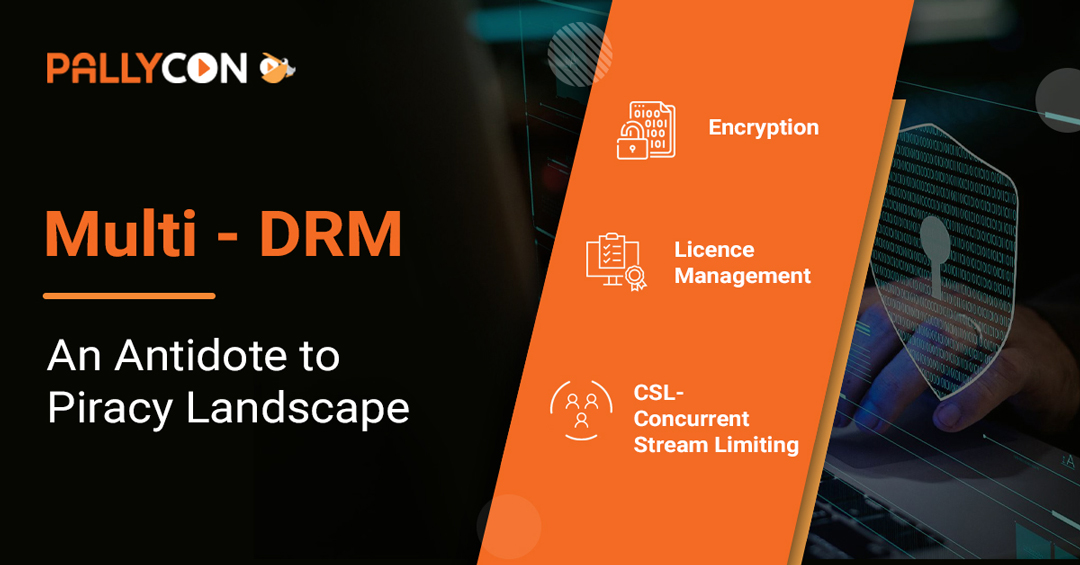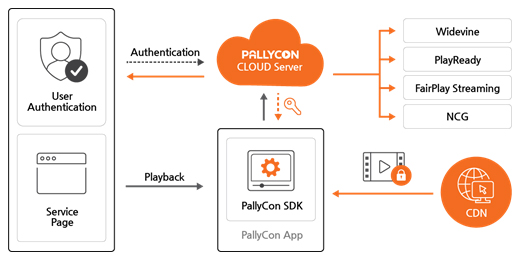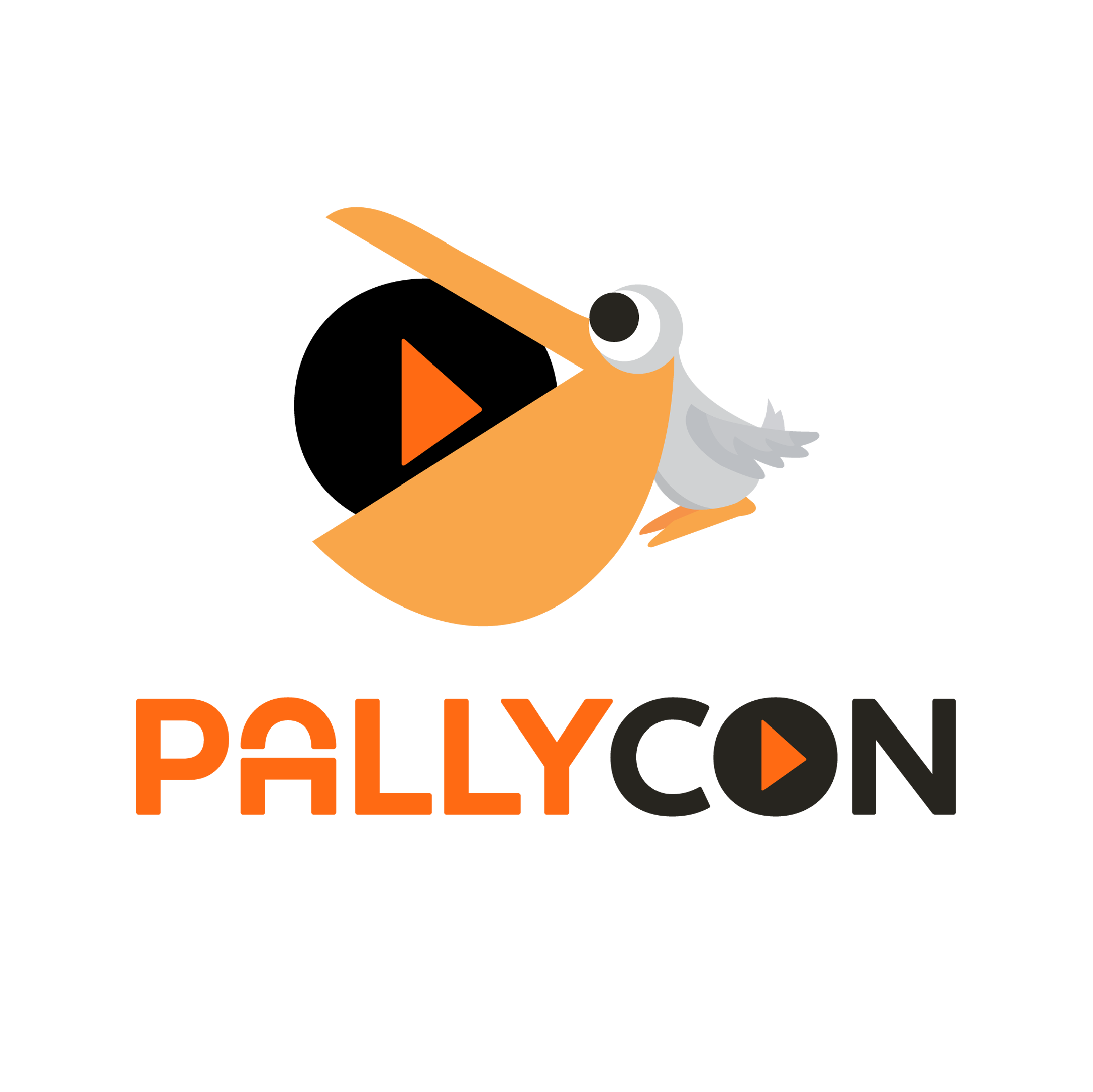
Multi-DRM – An Antidote to Video Piracy Landscape
The BIG Conundrum for Content owners and distributors
Content creators find themselves in a sweet spot. Post COVID-19-induced lockdown and proliferation of OTT space, there is a huge demand for high-quality, premium-grade VOD content, with sustained increases in subscription rates and viewing figures.
The global Digital Rights Management (DRM) market size is projected to grow from USD 4.3 billion in 2022 to USD 7.9 billion by 2027, at a CAGR of 13.0% . A prime mover behind this growth is the imperative need to protect intellectual property and the revenue stream of content creators and safeguard premium content against vulnerabilities posed by piracy in stealing and illegal distribution.
This outlook forces the key players in the content distribution framework to secure their content. A robust way to manage and secure end-to-end OTT content delivery is through multi-DRM service.
Multi-DRM enables legal access to digital video content with support to multiple platforms and devices (mobiles, laptops, tablets, desktops) and various browsers (Google Chrome, Apple Safari, Microsoft Edge). Contemporary Multi-DRM solutions come across as cloud-based license services with content packaging for a variety of DRM technologies like Microsoft PlayReady, Google Widevine, and Apple FairPlay Streaming.
What constitutes a DRM framework?
The building blocks of a DRM framework to establish the foundation for secure OTT streaming include:
1. Encryption
– DRM uses encryption to achieve data protection to protect premium content from piracy during the streaming or downloading.
2. License management
– DRM platform to manage the issuance of licenses by a DRM license server, including managing devices that can play content and track streaming devices. This component is essential to prevent unauthorized content distribution and ensures integrity against unwanted manipulation.
3. DRM-capable player
– This player communicates with the DRM server and enforces all playback restrictions. This is usually at the browser level via Media Source Extensions (MSE) and Encrypted Media Extensions (EME).
Related Article – Understanding Digital Rights Management
How does a DRM license framework work?
When a request is made to watch DRM-protected content, the user’s media player will need DRM-specific license information. DRM licensing business logic implementation should be in place to guide an appropriate action by the licensing architecture.
This information typically consists of the following pieces of information, also known as metadata:
- Content Key – the key used to encrypt and decrypt the content, usually done using an algorithm.
- Playback duration – frequency of DRM-protected content playback
- License type – A license may be persistent, in which case no further DRM license requests are required after the first one is made. Alternatively, a license request is made each time the content is requested for playback by the client.
The license contains a content decryption key in an encrypted format with some rules on how to use the content. The client player evaluates the rules and policies contained in the license. The client may be hardened via software/hardware against tampering and ensures that the content decryption key is released only to trusted playback systems.
Since the DRM licensing information sent to a client differs based on the DRM support (PlayReady, Widevine, FairPlay, etc.), including support on mobile devices, it becomes even more necessary to have a robust multi-DRM service in place to make the protection truly effective.
Complexities abound for Multi-DRM Service
A robust, effective multi-DRM service is expected to fulfill a minimum set of requirements so that the content owners and distributors can manage the entire end-to-end content distribution workflow seamlessly and counter piracy threats.
These features include, but are not limited to:
- High on scalability and performance, including integration with CDN infrastructure
- Reliable services for globally deployed content management
- Address fragmented device and operating systems
- Enforce content policies at the end user point of access
- Delay-free, seamless DRM workflow without impacting user experience
- Upgrade the security processes regularly to stay ahead of the curve
- A mechanism to monitor and adhere to licensing and protection agreements, especially with download and device storage
- Adhere to Enhanced Content Protection (ECP) parameters, as defined by MovieLabs for premium 4K/UHD content.
Subscribing to a cloud-based SaaS like PallyCon Multi-DRM License service provides you the ability to apply a high level of content security easily and quick integration with HTML5 web players. Together with the power of Forensic Watermarking, you can level up your revenue protection by detecting content leakage right at the source and issuing takedown notices.
PallyCon multi-DRM Service
PallyCon multi-DRM Service consists of three buckets – content packaging to apply DRM to content, DRM license services, and client SDK Solutions for DRM content playback. Let us have a look at each of these in more detail.
PallyCon multi-DRM license
PallyCon multi-DRM license is a cloud-agnostic SaaS service built on AWS and provides content key management and license issuance for PlayReady, Widevine Modular, FairPlay Streaming, and NCG (Netsync Content Guard) DRM. It offers various integration options and flexibility to customers to manage keys, either through a callback gateway method or a token.

The above diagram illustrates the working of the PallyCon multi-DRM solution.
PallyCon SDK requests licensing information to the PallyCon multi-DRM server, which then authenticates the callback page and issues a license corresponding to the device’s DRM. The Callback page serves as the mechanism to apply playback and content policies.
To get more details about the scope of DRM Content License support and Spec, visit https://pallycon.com/license-service/
Content Packaging
Packaging helps in encrypting the content before applying multi-DRM. Transcoding and Packaging can also be performed through PallyCon T&P Service, with the content converted to DASH or HLS stream format suitable for OTT. It is a complete SaaS-based solution to transcode, encrypt with multi-DRM, and apply forensic watermark in a single workflow. The solution is intuitive, easy to use, economical and quick, enabling a quick Time-to-Market. Visit this link for the step-by-step guide for PallyCon’s SaaS-based Transcoding and Packaging service https://pallycon.com/docs/en/tnp/tnp-service-guide/.
Encoder solutions supporting CPIX-based key exchange can be linked with PallyCon multi-DRM. This is useful in applying multi-DRM as it is a standard for interfacing encryption keys in content packaging and prevents the complexity of having multiple encryption key exchange functions for each DRM support.
PallyCon has a DRM CLI Packager which uses Command Line Interface (CLI) for content packaging in Windows and Linux. It is a file-based, on-demand (VOD) content-only packager. For live-stream content, content packaging methods like AWS Elemental Media Services, Wowza Streaming Engine, and Dolby Hybrik can be used. For more details, visit https://pallycon.com/docs/en/multidrm/packaging/
Related Article – Content Packaging -5 Things You Need to Know About Multi-DRM Technology
Multi-DRM SDK
To play the encrypted content, the player app must be developed using PallyCon SDK. PallyCon multi-DRM SDK helps in applying DRM across platforms and devices, including Windows, iOS, and Android. With integrated license management and pre-built download capabilities, it becomes easy to develop multi-DRM client applications. What is more, it supports even older OS that native DRM does not support.
Some of the security features include certificate-based secure communications and license management and key protection with white-box encryption. It supports an offline environment also.
Support for media formats includes MP4 Video/Audio files, MPEG-DASH fMP4, HLS, H.264, and AAC codec, among others. Visit https://pallycon.com/docs/en/multidrm/clients/ to know more.
PallyCon Multi-DRM: an effective, reliable antidote to piracy
Piracy is here to stay, taking on multiple forms and posing greater challenges for content owners and distributors. The fragmented device ecosystem only makes the challenge more complex.
Not to worry! Handle piracy threats head-on with experts like PallyCon’s cloud-based multi-DRM and future-proof your business revenue stream! Register with PallyCon today for a free trial!

PallyCon provides cloud-based SaaS multi-DRM solution and Forensic Watermarking service. Cloud services built on AWS enables you to use services in the cloud. Get started contents protection quickly and easily with PallyCon.



